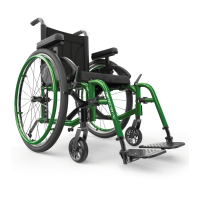RIDING YOUR WHEELCHAIR – FOLDING WHEELCHAIRS | USER MANUAL
13
T 1-866-650-6555 F 1-888-966-6555 E-mail info@motioncomposites.com
3. ALWAYS have someone assist you until you learn your chair’s
balance points and are completely comfortable in your ability to
operate your chair under all conditions so as to avoid tip-overs.
4. ALWAYS use both anti-tippers.
If you ignore these Warnings, you may fall, tip over or lose control
of the wheelchair and seriously injure yourself or others or damage
the wheelchair
6.4.2 BALANCE POINT
– It is important to begin by learning all of the specific
characteristics of your wheelchair. Ask a health professional
to explain them to you.
– Carrying a backpack will affect the balance point of your
wheelchair.
– Be aware of resulting handling factors in relation to your body
position, posture or weight distribution.
– The center of gravity is affected by the angle of the wheelchair
on a ramp or slope.
– This can be felt in forward and backward as well as side to side
movements.
– Make sure to review the different riding techniques prior to
using the wheelchair. Use anti-tippers until you are skilled at
riding your wheelchair in any situation
6.4.3 WHEELIES
– Raising the wheelchair involves lifting the front wheels off
the ground and maintaining balance on the rear wheels
(called a wheelie).
– DO NOT attempt to perform a wheelie in your wheelchair
because of the dangerous nature of this kind of maneuver.
Motion Composites recognizes that some wheelchair users will
ignore this warning. If you should choose to ignore this warning,
you should follow these steps to help learn to do a “wheelie” as
safely as possible.
– NEVER attempt to learn to do a wheelie without first consult-
ing your health care advisor. NEVER attempt to learn to do a
wheelie without an assistant that can catch you if you should
happen to start to fall. NEVER attempt to learn to do a wheelie
unless you are a skilled rider on this chair.
– Motion Composites always recommend using both anti-tippers
at all-time unless they need to be removed to go up or down a
curb/step.
WARNING
Both anti-tippers should be reinstalled once the curb/step
is cleared.
6.4.4 TRANSFERRING
– Rotate the front casters forward to enhance stability.
– Place the wheelchair as close to your transfer location
as possible.
– Engage wheel locks.
– Position yourself as far back as possible when transferring
weight to reduce risk of tipping forward.
– If you have good upper body strength, balance and agility,
you may be able to perform transfers independently.
– Rotate or remove footrests if at all possible as to avoid putting
weight on them. If possible, make use of a transfer board.
WARNINGS
Always ask a healthcare provider to learn safe transfer
methods.
DO NOT sit or transfer into the wheelchair unless it is fully
open and the seat frame rails are fully seated into the
receivers.
DO NOT use the footplate as a platform when getting in or out
of the wheelchair or to reach for an object
6.4.5 GETTING DRESSED
– When dressing or undressing on the wheelchair, rotate the
front casters forward and lock anti-tippers in the lower position.
– If your wheelchair is not equipped with anti-tippers, back it
against a wall and lock the rear wheels.
6.4.6 REACHING/LEANING/BENDING
WARNING
The balance point may shift when you are putting on clothes
and/or reaching for objects while sitting in the wheelchair.
– If at all possible, use a reaching device or ask for assistance
when reaching for objects.
– Move the wheelchair as close as possible to the required object.
– Rotate the casters as far forward as possible from the rear
wheels.
– Never reach for objects between your legs, but rather position
yourself to the side of these objects.
– DO NOT shift your weight sideways, but rather rise up from the
seat or move forward in the seat. Always use both hands and
grab the opposite side wheel or armrest if you are capable of
reaching sideways.
– Never reach to the rear of the wheelchair unless it is equipped
with anti-tippers Never reach for objects over the seat back:
reach only as far as your arm naturally extends without moving
on the seat.
– DO NOT lock the rear wheels if you are reaching backwards.
– Avoid putting pressure on the footrests.
6.4.7 MOVING BACKWARDS
– Lock both anti-tippers in lower position.
– Move slowly: the wheelchair is designed to provide you with
more stability when moving forward. Look around as often as
possible to avoid obstacles in your path.
6.4.8 RAMPS, SLOPES & SIDE HILLS
RAMPS OF 10 FEET (3 METERS) OR LESS IN LENGTH
– If you need to use a short ramp 10 feet (3 meters) or less,
the angle of the slope should not exceed 10 degrees,
which corresponds to a slope of 17.63%, a rise of 1.74 feet
(0.53 meters) over a distance of 10 feet (3 meters).
– Make sure to be assisted by a caregiver who has the physical
ability to retain the wheelchair and its occupant. The wheelchair
must always point facing up the slope.

